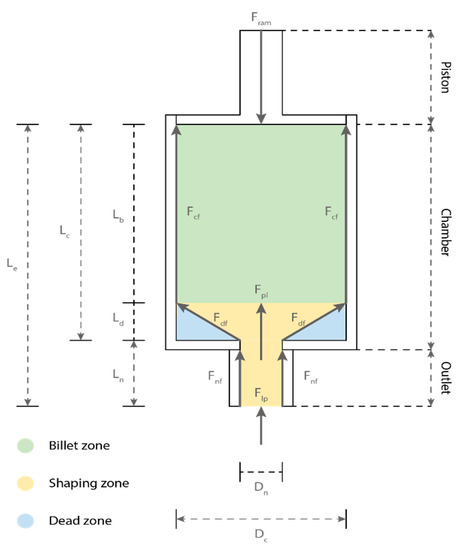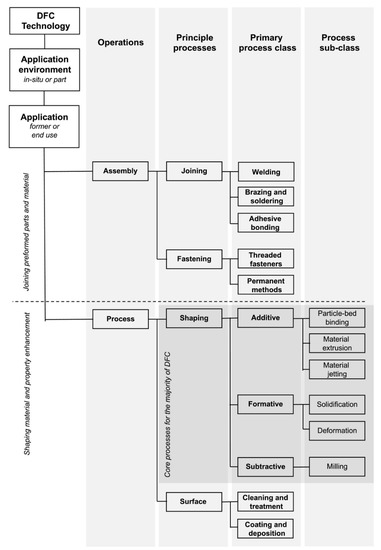Depending on the material design, mechanical design (i.e., extruder system design), and operational design, different extrusion behaviors can be observed. A general extruder system is shown in
Figure 2, which consists of (1) a piston (ram extrusion mechanism); (2) an axis-symmetric chamber with a diameter of D
c and a length of L
c; and (3) a nozzle (outlet) with a diameter of D
n and a length of L
n. The studies
[17][18][19][20][17,18,19,20] allow the authors to generalize the extrusion behavior of FCP using such a ram extruder system. To enable a successful extrusion, the extrusion driving force, F
e (in this case, ram extrusion force, Fram), has to overcome extrusion resistive forces that are responsible for the extrusion pressure drop
[21][22][23][21,22,23], which may include: (1) the chamber wall shear force F
cf (or friction force) in the billet zone; (2) the shaping force F
pl in the shaping zone, also known as the die entry pressure, which is responsible for the plastic deformation of FCP between the chamber and outlet; (3) the nozzle wall shear force F
nf (or friction force) in the shaping zone, also known as die land pressure; (4) the dead zone shear force F
df (or friction force) in the dead zone; and (5) the layer pressing force, F
lp needs to be taken into account when the layer pressing extrusion mode is adopted.
3. Deposition Process and Positioning System
Deposition is an additive process where a material is layered onto another layer of the material. During the E3DCP deposition process, the most important property is the buildability, which is defined as the ability of the deposited concrete filament to self-support and resist deformation without formworks
[12][25][12,106]. The buildability stipulates that the concrete filament should provide sufficient resistance against plastic material failure, elastic buckling failure as well as excessive deformation
[26][107]. However, the mechanical design of the positioning system has a relatively insignificant impact on the buildability compared to the material design. Therefore, the following section presents the mechanical design of the positioning system from a more practical perspective.
Four types of E3DCP positioning systems can be identified: gantry system, robotic arm system, delta system, and swarm system. Each category is characterized by a different degree of freedom and build volume.
The gantry system is the most common positioning system for E3DCP applications due to its ease of operational and cost-effectiveness. A gantry system is generally characterized by three DOFs of translational movements in x, y, z directions (Cartesian coordinate), but sometimes an additional rotational DOF can be added at the extruder to have four DOFs
[27][28][108,109]. The build volume of the gantry system is constrained by the physical dimensions of the supporting frames in x, y and z directions, and it could range from desktop-scale for laboratory purpose to industrial-scale for construction purposes, see
Table 2. To overcome the limited dimension of the gantry system, COBOD
[3] has developed a flexible-dimension gantry concrete printer, BOD2, which could be assembled from multiple modular units of 2.5 × 2.5 × 2.5 to fit different construction scenarios. The contour crafting company
[29][60] and IconBuild
[30][110] retrofitted the gantry concrete printer with sliding rails to expand the workspace in one horizontal direction. From a practical standpoint, the robustness of the gantry system can sustain the on-site harsh conditions, however, it could be associated with considerable manual works in assembly and disassembly
[31][62]. Additionally, the accuracy and repeatability of gantry printers are sufficient to complete large-scale E3DCP projects but they are not comparable to the robotic arm system.
The robotic arm system printer generally consists of multiple links connecting altogether at rotary joints, which provides the system with more DOFs (six or more) and allows it to print more sophisticated designs. For example, Lim et al.
[32][111] have pointed out that the staircase effect that typically associates with the extrusion-based 3DCP can be mitigated by adopting the curved-layer printing strategy instead of flat-layer printing. Concretely, in this approach, the extruder nozzle is positioned perpendicular to the target surface throughout the extrusion process so that the surface roughness and geometric accuracy can be improved. To fully exploit the potential of this approach, a position system with four or more DOFs is essential. Similarly, Gosselin et al.
[33][112] recommended utilizing a six-axis robotic arm to realize the tangential continuity method for toolpath planning, which could produce non-planar layers with locally varying thicknesses, thereby unleashing the geometrical freedom of E3DCP to a greater extent. The approach has been used to 3D print multifunctional structures such as the thermal insulation wall and acoustic damping wall. Motamedi et al.
[34][113] utilized a six-axis ABB robotic arm to print an overhang structure without support, which is only possible with the capability of the robotic arm to adjust the angle between the nozzle and printing surface.
However, most industrial robotic arms (e.g., Kuka, ABB and Fanuc) have limited workspace. Once set-up, they can only print structures within a pie-shaped zone formed by the arm reach (generally less than 5 m), which will not suffice for conducting large-scale 3DCP projects. There have been various strategies proposed to extend the reach of the robotic arm: (1) installation of the extension arm at the extruder end
[35][114]; (2) lifting of the robotic arms: the construction company Apis Cor
[36][115] employed a crane to lift the pillar-like robotic arm printer after finishing printing tasks at one point; (3) provision of mobility to the robotic arm: the construction company Cybe
[37][116] and the research team from NanYang Technical University
[38][117] have both installed a mobile base underneath the robotic arm to enable theoretically infinite workspace in horizontal direction, and the research team from TU Dresden conceptualized the adaptation of a truck-mounted pump for E3DCP. However, such an approach imposes more strict requirements on the spatial localization of robotic arm, site conditions (e.g., flatness) as well as the weather conditions (e.g., low wind); (4) carrier system: ETH Zurich researchers
[39][104] installed a six-axis ABB IRB 4600 robotic arm on a Güdel 3-axis gantry at ceiling to increase both the horizontal and vertical workspace, and the team from TsingHua University
[40][118] provided an elevator platform to extend the workspace; and (5) multiple robotic arms: Zhang et al.
[41][119] employed two mobile robotic arms to print structure simultaneously. Such an approach requires complex robotic path planning as well as collision checks before printing. Despite the multitudinous benefits of robotic arms, compared to the robustness of the gantry system, the delicacy of the robotic arm system has raised the suspicion of its suitability for rough on-site conditions, which explains why the majority of robotic arm printers are used under off-site conditions
[31][62].
Apart from the mainstream gantry and robotic arm systems, there have been some innovative systems developed for E3DCP applications. For example, the construction company WASP
[4] has customized a Delta 3D concrete printer called BigDelta with a dimension of 7 × 7 × 12 m. The printer consists of three cable-arms connected to joints at frame supports, and each arm could move independently in the y-direction, forming a navigation based on the polar coordinate. The German Fraunhofer Institute
[42][120] also developed a similar delta 3D concrete printer based on eight cable arms. The delta system also has dimension constraints within the frame, and it also suffers from a higher risk of collision with the already printed parts compared to the gantry system
[31][62]. The Institute for Advanced Architecture of Catalonia
[43][121] has designed three swarm 3D concrete printers that could work collaboratively to produce structures: (1) the base robot, which deposits the first ten layers of concrete filaments to create a foundation; (2) the grip robot, which rests on the previously bult foundation and continues deposition to finish the structure; and (3) the vacuum robot, which climbs on the surface of the finished structure and deposits concrete filaments in z-direction. Theoretically, without considering the layer cycle time, such a swarm system can be used to construct large-scale concrete structures without dimensional limitation, especially in horizontal directions. Nonetheless, the technology remains relatively nascent and needs more exploration.
Table 2.
Some examples of 3D concrete printers in terms of position system, build volume, horizontal printing speed, layer height and layer width.
4. Advanced Sub-Processes and Advanced Fittings
According to the literature the authors have reviewed, the advanced fittings can be classified as the secondary mixing, setting-/fluid-on-demand, in-process reinforcement, interlayer bonding enhancement, finishing, support placement and monitoring, and feedback processes. The inclusions of the advanced sub-processes within the printing system generally increase the energy, machine and maintenance costs (in the passive systems, the energy increase may be insignificant). Additionally, they may increase the energy and material costs as well as the technical complexity of the overall system, as shown in
Table 3.
Table 3.
The material costs and technical complexity of the advanced fittings.
|
Advanced Fittings
|
|
Material Cost
|
Technical Complexity *
|
Low, when the system is a passive system; medium, when the system is automated but independent of the printing path and programming; high, when the system needs to be integrated and programed with the printing path definition to perform its intended task; high *, when the system could be coupled with the printing path to achieve functional-graded materials.


